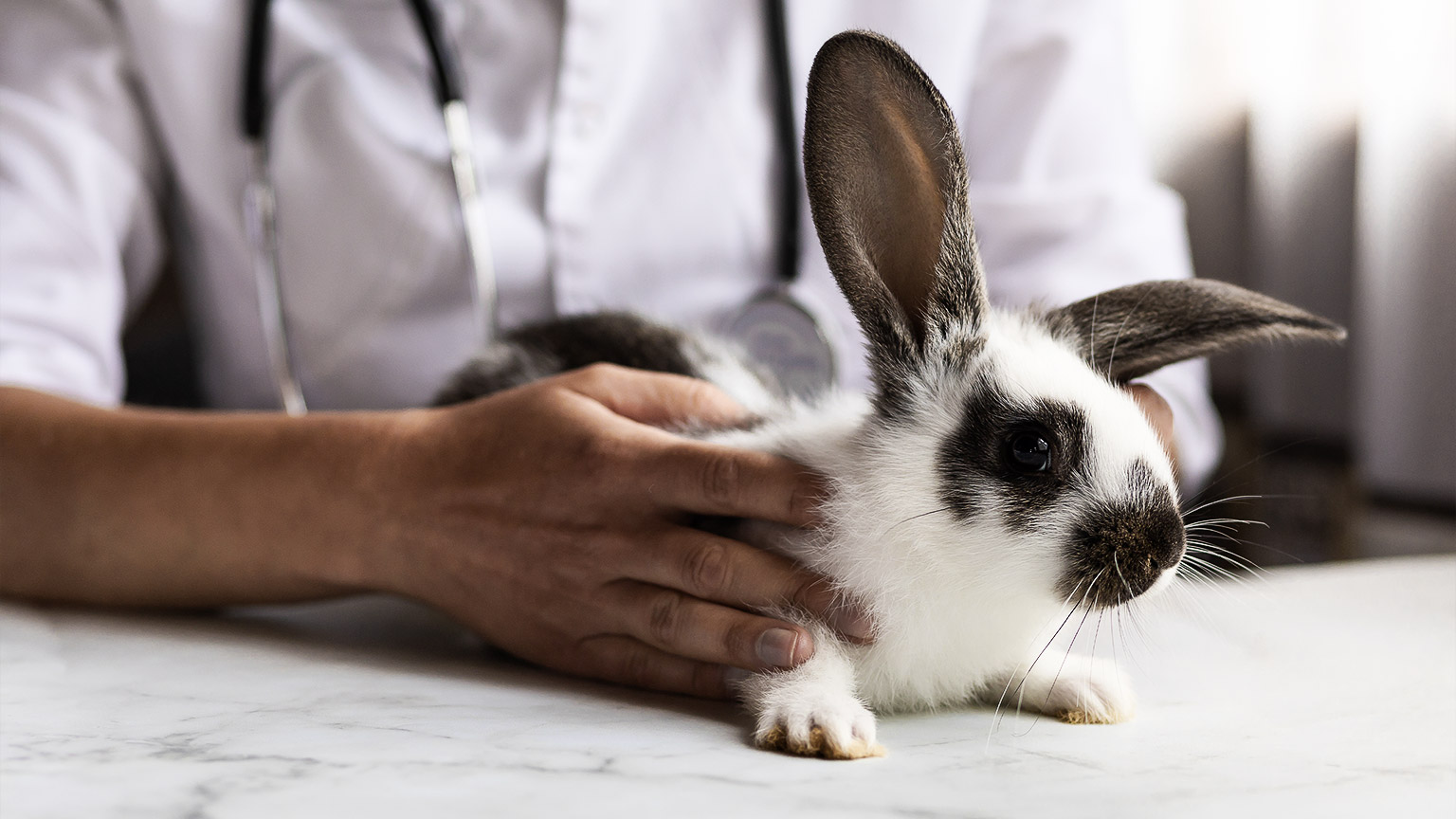When an animal comes into the clinic, it is very important that you are able to recognise the signs of any potential infectious disease that the animal may be presenting. This is also known as triage; assessing the severity of the illness to determine how best to treat it. Some patients may present minor conditions, while others may be presenting signs of a more serious condition. The triage process is very important because if there is an emergency, the animal will need to be treated immediately. There are special forms each clinic will have for triage purposes.
When the animal is suffering a serious condition the animal may present signs of:
- chewing or licking own body excessively
- defensive behaviours
- drooling and regurgitating food
- excessive drinking
- excessive rolling
- general changes in normal behaviour or routines
- lameness
- listlessness or disinterest in surroundings
- presence of blood, swelling, excessive heat
- reluctance or refusal to eat or drink
- reluctance to move
- sweating
- yelping or other vocalising when touched or if animal attempts to move or perform particular tasks or grooming.
It is important you never assume the animal will not bite you: no matter how well you know them always examine with caution. If you have any doubt during the examination process, you should always ask the veterinarian or experienced member of the team to assist you.
When you are preparing for examination, ensure you (or the relevant person at your workplace) have consulted with the owner and discussed what they have noticed to also be ready to conduct the physical examination. Once you have gathered enough information and observed the behaviour of the animal, you are ready to conduct the physical exam.
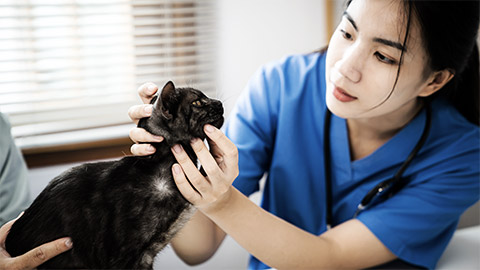
When assessing an animal’s health there are two main types of examination:
- Distance assessment (hands-off)
- Physical examination (hands-on).
Distance Assessment
During a distance assessment, you observe the animal’s temperament, demeanour and behaviour as well as look for visible signs of health or health issues, including:
- assessing the animal’s breathing by listening to and watching the animal breathe, asking yourself questions such as:
- Is breathing easy or laboured?
- Are the breaths deep, shallow or irregular?
- Can you hear choking, whistling, gasping, excessive coughing, wet noises or other strange sounds while the animal breathes?
- looking for any obvious signs of bleeding, broken bones, vomiting or unusual evacuation (diarrhoea)
- looking for any issues with coat condition, for example, matted or missing fur
- looking for unusual posture or movement if the animal is already standing. If you suspect broken bones or spinal damage, do not encourage the animal to stand or move.
Demeanour is the general, observable behaviour and alertness of an animal. An animal’s demeanour is often an indication of injury, illness or disease.
Observe the animal’s behaviour and note its demeanour. The following terms are commonly used to indicate the demeanour:
- BAR - Bright, alert and responsive
- QAR - Quiet, alert and responsive
- Altered mentation
- Neurological
- Seizure
- Post-ictal – phase immediately following a seizure
- Depressed or dull
- Obtunded – lethargic or sleepy
- Stuporous – unconscious or very difficult to rouse
- Comatose.
You should conduct a distance assessment before you approach and capture an animal and at the start of a health assessment. The particular demeanour, behaviour of the animal as well as any external signs of injuries, should influence your choices around how to approach, capture, handle and restrain that animal. Review the learning on animal behaviour and handling animals from previous modules.
Physical Examination
A physical examination of an animal involves checking the animal’s vital signs and external features as indicators of general health and well-being. We will look at vital signs in detail in the next topic.
Physical examinations will include the following:
- temperature
- pulse rate
- respiratory rate
- abnormal lung sounds
- ears
- eyes
- mouth (if the animal will let you).
- skin
- limbs
- neck
- head
- chest
- stomach
- tail
- back
- paws.
Checking the vital signs of an animal will give you a broad idea of the animal’s health. Vital signs can change quickly in response to the animal’s activity or emotional state. You may need to take the animal’s vital signs repeatedly to see if they are stable. If the vital signs are outside their normal ranges for a prolonged period, it may be an indication that something is wrong.
However, minor health and maintenance issues may not be detected while checking vital signs. Instead, a physical examination to identify external features of health will help you to determine the overall health status of the animal.
You do not generally need specialist equipment to conduct a physical examination of an animal. In most cases what you can see, hear and feel is enough to identify health problems that require treatment.
Low stress examination
As with approaching, capturing and handling animals, it is best for the animal to use low stress methods. Minimising the stress an animal experiences will also make them easier to examine.
When examining an animal try to:
- use the minimal amount of restraint possible; ideally, just use your hands
- use the minimal amount of force possible
- make the animal feel physically supported at all times
- avoid startling the animal
- avoid loud or sudden noises, including minimising environmental noise
- avoid sudden movement.
Body condition score
A body condition score (BCS) is an indication of the body fat level of an animal, relative to its size. BCS provides an indication of overall health in terms of nutritional status and healthy body weight.
There are two scales typically used for BCS:
- 1-5: Where a score of 1 is severely underweight; 3 is ideal weight; 5 is severely overweight
- 1-9: Where a score of 1 is severely underweight; 5 is ideal weight; 9 is severely overweight.
To determine the BSC of an animal you need to observe the animal from above and from the side as well as feel the animal around the ribs, backbone and hips. From above you should see a clear waistline, and, from the side you should see the abdomen slant upward from the lowest part of the ribcage towards the hind legs. When you feel the animal along its backbone, and across the ribs and pelvic bones, you should be able to feel the bones through the body fat with only light pressure. However, the bones should not be visible through the skin (Williams & Buzhardt n.d.).
Assigning a BCS is subjective. However, there are pictorial charts for many animal species to help guide the assessor, such as those provided by The World Small Animal Veterinary Association (WSAVA):
- Body Condition Score (pdf) (chart for cats) Body-Condition-Score-cat-updated-August-2020.pdf (wsava.org)
- Body Condition Score (pdf) (chart for dogs). Body-Condition-Score-Dog.pdf (wsava.org)
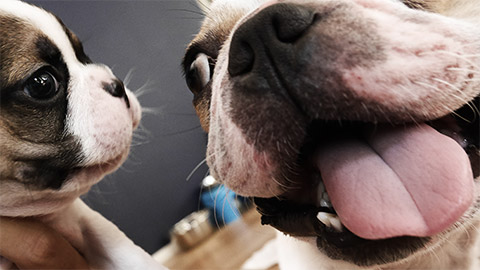
To give an animal an overall physical examination, it is best to work systematically, so you don’t accidentally skip something. The key external features to examine are:
- Hydration
- Eyes and nose
- Mouth
- Ears
- Lymph nodes
- Lungs
- Abdomen
- Anus
- Limbs
- Skin.
Follow the advice of your supervisor regarding the order in which to carry out the health checks. Monitor the animal’s behaviour throughout the examination. If any of the techniques cause the animal discomfort or pain, you may be at risk of being bitten or scratched. Adjust your level of restraint throughout the examination in response to any changes in the animal’s behaviour or temperament.
Hydration level
The hydration status of an animal is an indication of the amount of water present in the body. Water is essential for most bodily processes as well as for maintaining good blood pressure. Dehydration occurs when the animal can’t (or won't) drink enough or if they lose water through repeated vomiting or diarrhoea.
Dehydration can cause organ damage and even death in severe cases. Dehydration is particularly dangerous in small and young animals, such as puppies and kittens, because it can happen very quickly.
There are two common ways to assess the hydration status of an animal:
- The skin tent test
- The gum test.
Skin tent test
To conduct a skin tent test (also known as the skin turgor test):
- Gently pinch and lift the skin between the shoulder blades, forming a ‘tent’ shape.
- Drop the skin.
In a well-hydrated animal, the skin should spring straight back to its normal position after you release it. If the skin returns slowly or remains in the tented position, it indicates dehydration. The longer the skin takes to return, the more severe the dehydration.
Note: Older animals may have less elastic skin that may tent a little longer than younger animals (Australian Red Cross n.d.). Some breeds naturally have rolls of skin, such as Shar-pei dogs. So, be sure to take this into consideration when assessing the return time of the skin.
Gum test
To conduct a gum test:
- Gently lift the upper lip of the animal and look at the gums.
- Use your finger to touch the surface gently.
In well-hydrated animals, the gums should look glossy and wet. In dehydrated animals, the gums tend to look dull and are sticky to the touch (Bond Vet 2020). Note: Always be careful when going near an animal’s mouth. If there is any risk of being bitten, do not attempt this test.
Eyes and nose
Look closely at the animal’s eyes and nose.
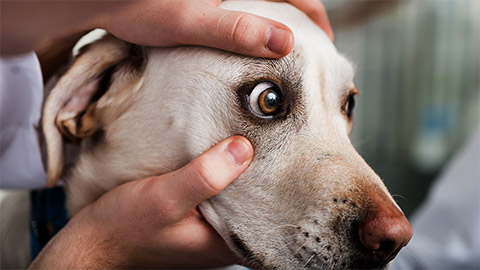
Eyes
The eyes should appear moist, clear and bright. The whites of the eyes should appear white with only a few visible blood vessels. The pupils should be the same size, should contract equally when exposed to a bright light and expand when the room is darkened (Gfeller, Thomas & Mayo 2020).
Abnormal signs to check for include:
- unusual or excessive discharge
- tear staining (fur around the eyes is stained pink)
- inflammation (redness or swelling) of eyelids
- pupils that do not respond normally to changes in light conditions
- colouration of the whites of the eyes.
Nose
A common misconception is that healthy animals should have a ‘wet nose.’ This is not true.
Instead, check the nose for unusual or excess discharge, cracks and bleeding.
Mouth
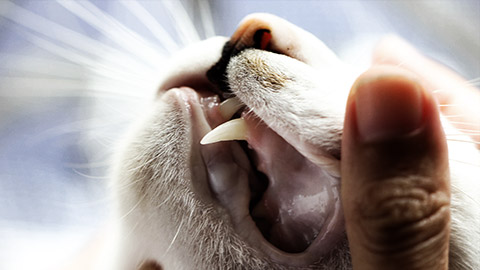
As always, only check an animal’s mouth and teeth if it is safe to do so.
A healthy mouth should have moist pink gums and clean, white teeth. When checking an animal’s mouth note:
- bad breath
- plaque or tartar on the teeth (usually around the base of the teeth)
- inflammation of the gums (periodontal disease)
- missing or broken teeth.
Ears
Ear shape and posture vary greatly between species and breeds. However, all healthy ears should be clean and dry, have little-to-no odour and be pain-free when touched.
Signs of health issues in the ears include:
- inflammation
- discharge
- strong smell
- erythema (skin irritation and redness)
- pain or tenderness
- wounds, scabs, lumps or rashes on the skin
- signs of external parasites.
Lymph nodes
Lymph nodes are a key part of the immune system. They are sites around the body where white blood cells gather and fight pathogens. Swollen or painful lymph nodes are a common sign of infection.
The largest and easiest lymph nodes to locate on a mammal, especially for cats and dogs, are found in the neck, chest, armpits, groin and behind knees (Dogtor Pete 2022).
Gently palpate (feel around carefully with your fingers) the areas where the lymph nodes are located. If they are swollen, you should feel hard lumps quite easily. However, if you’re unsure what it is you are feeling for, it is easy to mistake other lumps (such as swollen salivary glands) for swollen lymph nodes. If you find a lump that you suspect is a swollen lymph node, ask your supervisor or a vet to check.
Lungs
You will have assessed the animal’s breathing during your distance assessment. However, if you have access to a stethoscope, you can use it to listen to the lungs and detect quieter sounds of breathing difficulties.
Abdomen
Gently palpate the abdomen (stomach area), starting just behind the ribs and working your way down to the pelvic bone. Feel for lumps, bumps and masses, tightness and bloating. If the animal has difficulty breathing or shows signs of discomfort or pain during the process, it could indicate a serious problem (Gfeller, Thomas & Mayo 2020).
Anus
Life the tail, if necessary, to examine the animal’s anus. Check for faecal staining, which could indicate diarrhoea, and for enlarged anal glands, which may indicate a blockage.
Limbs
Examine each limb, starting at the foot. Check:
- claws/nails/hooves for:
- damage or absence
- overgrowth
- discolouration.
- foot pads for:
- lodged grass seeds or other foreign bodies
- injuries
- swelling or inflammation.
- for broken bones
- for range of motion through each joint.
Skin
Finally, skin condition can be a good indicator of the overall health of the animal. Run your hands over the whole of the animal to check for abnormalities, including:
- wounds
- missing fur/hair or poor coat condition
- lumps, bumps or masses
- excessive oil or discharge
- unpleasant odour
- foreign objects and ectoparasites, such as ticks.
The following video provides a full demonstration of a basic health check on a dog. You are not expected to conduct a full examination by yourself. However, it is in your best interest to observe the demonstration, so you are more familiar with the process and can better assist the vet or other staff member conducting the examination.
Watch
How To Perform A Clinical Exam On Your Dog | Vet Demo
In this veterinary demonstration, Dr. Pieter de Villiers will show you the correct step-by-step process when examining your dog. This video should be helpful for both pet owners and vet students alike, as the process is similar whether you have a lot of knowledge about dogs or if you are just a loving pet parent.
Expected Duration: 10:57 minutes
Post Watch Task:
- How does Dr Pieter prepare for the examination?
- What specific checks does he perform?
- What are Gracie’s vital signs? (Heart rate, body score, temperature)
- What is Gracie’s overall health status?
When assessing an animal’s health, it is important to maintain accurate records. This information contributes to the patient’s history and may help with diagnosis or treatments in the future.
When recording observations, it is important to include all the relevant detail, while being concise.
What observations to record
The specific information you need to record will depend on your workplace and the purpose of the health check. For example, a veterinary clinic will keep different health care records from a boarding facility. If you were monitoring the ongoing health of an animal in a shelter, you might only record your observations from the distance assessment, while you may need to record repeated vital sign checks over a period of time in a first aid situation.
Follow the specific procedures for your workplace and remember to use appropriate industry terminology, abbreviations and units as appropriate. Confirm the requirements with your supervisor if you are not confident.
Some common health observations that you may need to record include:
- the weight of the animal (kg)
- body condition score (BSC)
- the amount of food/water consumed
- evidence of urination or defecation
- demeanour and behavioural observations
- distance assessment observations
- observations of coughing/sneezing
- vital signs
- other physical examination assessments.
How to record observations
The specific method of recording observations will vary between workplaces. Some workplaces may use an app on a mobile device, others may record observations manually on a form or on a computer database. Again, follow the procedures of your workplace.
Review the article, ‘Instructions for daily monitoring of animal health and behavior’ (Instructions for daily monitoring of animal health and behavior - Koret Shelter Medicine Program) , for more information about the importance of record keeping in an animal shelter. You can view six sample record forms by following the links at the bottom of the article. Take note of the abbreviations and codes used to quickly and accurately record observations.
Industry terminology
When recording health observations, it is important to use appropriate industry-accepted terminology and abbreviations. That way when someone else reads your records, they will understand what you meant. For example, hyperthermia is the correct term compared to simply saying ‘overheating’ or ‘too hot.’
Abbreviations are an excellent way of taking notes quickly. However, don’t make up your own! Use the industry standard abbreviations. If you make up your own abbreviations or shorthand, other people will have difficulty understanding your records.
Common disease and treatment abbreviations
When assisting in the health care of animals, it is important to recognise and understand the common industry standard abbreviations used. A full list of abbreviations for the animal care industry can be found at the end of this module.
The following tables list some of the most common abbreviations used related to health care in animals.
| TREATMENTS | DESCRIPTION | TREATMENTS | DESCRIPTION |
|---|---|---|---|
| Abs | Antibiotics – drugs used to treat bacterial infections | BB | Bordatella bronchiseptica (vaccine) |
| C3 | Canine 3 vaccine - Distemper, Hepatitis and Parvovirus | C4 | Canine 4 vaccine - Distemper, Hepatitis, Parvovirus and Parainfluenza |
| C5 | Canine 5 vaccine - Distemper, Hepatitis, Parvovirus, Parainfluenza and Bordatella bronchiseptica | C7 | Canine 7 vaccine - Leptospirosis, Distemper, Hepatitis, Parvovirus, Parainfluenza and Bordatella bronchiseptica |
| EAGs | Express anal glands or empty anal glands | F3 | Feline 3 vaccine - Enteritis, Rhinotracheitis, Calicivirus, Chlamydia |
| F4 | Feline 4 vaccine - Enteritis, Rhinotracheitis, Calicivirus or Feline 4 vaccine - Enteritis, Rhinotracheitis, Calicivirus, Feline Leukemia | F5 | Feline 5 vaccine - Feline Panleukopenia Virus, Feline Herpesvirus, Feline Calicivirus, Chlamydophila psittaci and Feline Leukemia Virus |
| NSAID | Nonsteroidal anti-inflammatory drug, these are drugs commonly used for pain management. Should never be used in conjunction with Steroids. In most cases must be given with food. | Spey | Ovariohysterectomy – Surgical removal of ovaries, fallopian tube, uterine horn, and body. Desexing of female. |
| r/s, s/r, s/o | Remove sutures e.g., r/s 10 days |
| DISEASE AND INJURY ABBREVIATIONS | DESCRIPTION | DISEASE AND INJURY ABBREVIATIONS | DESCRIPTION |
|---|---|---|---|
| Canine Cough | Colloquialism for a group of contagious bacterial and/or viral diseases that cause a cough in dogs. Also referred to as Kennel Cough by some vaccination brands. | HBC | Hit by car |
| CBA | Cat fight bite | HW | Heartworm |
| CDV | Canine distemper virus | IBD | Inflammatory bowel disease |
| CFA | Cat fight abscess | ICH | Infectious canine hepatitis |
| CPV | Canine parvovirus | IVDD | Intervertebral disc disease |
| DJD | Degenerative joint disease | NAD | No abnormalities detected |
| FAD | Flea allergy dermatitis | OA | Osteoarthritis, degenerative joint disease |
| FCV | Feline calicivirus | PBFD | Psittacine beak and feather disease |
| FeLV | Feline leukemia virus | PRA | Progressive retinal atrophy |
| FIA | Feline infectious anemia | RCD | Rabbit calicivirus disease (rabbit hemorrhagic disease) |
| FIP | Feline infectious peritonitis | UTI | Urinary tract infection |
| FIV | Feline immunodeficiency virus | IBD | Inflammatory bowel disease |
| fLUTD | Feline lower urinary tract disease | ||
| FRV | Feline rhinotracheitis virus | ||
| fx | Fracture (break in bone or tooth), also written as # for a broken tooth | ||
| GDV | Gastric dilatation-volvulus | ||
| GI | Gastrointestinal (tract) |
Ongoing monitoring
In animal care facilities where animals are kept for long periods of time, such as animal shelters, boarding facilities, wildlife sanctuaries or zoos, you will likely need to monitor the ongoing health of animals. In many workplaces, basic health monitoring occurs daily with more in-depth check-ups less frequently.
Daily monitoring allows you to observe changes in the animal’s condition. The three general updates regarding animal condition are:
- Deterioration (getting worse)
- Progress (getting better)
- No change.
You should report any signs of deterioration immediately to your supervisor.
Summary
This topic has covered:
- The different examinations (hands on or hands off)
- Low stress examinations
- Body condition scores
- The steps of a full body examination, including specific body areas
- What documentation should be completed
- Common abbreviations used in writing health notes
Activity
If you have a pet that you think would be comfortable with you handling them, use the content in this topic to give them a basic health check. Start with a ‘hands off’ assessment first. Only carry out the ‘hands on’ steps that you think your animal will be comfortable with. You won’t have access to PPE at home, but you will be able to practice your hand washing routines at the different steps of the health check. This will be good practice for your assessment for this module.
Note: if you notice anything unexpected please contact your vet for advice.
Hopefully, all went well with your basic health check. Let’s move to the next topic and learn about the five key vital signs when conducting a health check. Hoake tātou.
